中国科技论文在线
http://www.paper.edu.cn
C-反应蛋白研究现状及展望#
李京,吉尚戎**
5
10
(兰州大学生命科学学院生物物理所,兰州 730000)
摘要:C-反应蛋白(CRP)是一种典型的炎症急性期蛋白,其浓度在炎症发生时可在短时间
内升高 1000 倍以上。在人体中,CRP 通常由肝脏合成并分泌至血浆中。目前,CRP 主要作
为炎症的非特异性标识物用于临床上的检测。近些年来,研究发现 CRP 与慢性炎症疾病动
脉粥样硬化的形成有重要的联系。非急性期时,CRP 在血浆中浓度与患动脉粥样硬化的风
险成正比。但到目前为止,CRP 在炎症以及动脉粥样硬化形成中的具体作用依然是未知的。
本文主要回顾了迄今为止 CRP 研究领域的重要发现及最新进展,同时对 CRP 未来的研究方
向进行展望。
关键词:免疫学;炎症;动脉粥样硬化;C-反应蛋白
中图分类号:Q71
15
The current situation and prospect of the research on CRP
20
25
30
35
(1. Institute of Biophysics, College of Life Science, Lanzhou University
LI Jing, JI Shangrong
(Institute of Biophysics, College of Life Science, Lanzhou University,Lanzhou 730000)
Abstract: C-reactive protein (CRP) is a typical acute phase protein of inflammation.The
concentration of CRP can raise more than 1,000 fold in the acute phase. CRP is mainly expressed
in hepatic cells and secreted to the plasma. Now, it can be used as a nonspecific marker of
inflammation in clinical test. In recent years, CRP was found to be a predictor of athereosclerosis.
The basal level concentration of CRP in plasma is associate with the risk of atherogenesis. But the
precise function of CRP is not clear so far in inflammationary regulation and atherogenesis. This
review will focus on the current situation of the research of CRP and talk about the research trends
of CRP in the future.
Key words: immunology; inflammation; atherogenesis; CRP
0 引言
CRP是一种典型的炎症急性期蛋白。Tillet和Francis在1930年首次发现了CRP[1]。因其能
与肺炎链球菌表面的C多糖发生沉淀反应而得名CRP。1971年,Volanakis和Kaplan鉴定出C-
多糖上与CRP的物质是胆碱磷酸(Phosphocholine,PC)[2]。1977年,Osmand和Shelton利用
电子显微镜观察到CRP是一个五聚体环形分子。在1996年,Shrive和Greenhough利用X射线
衍射的方法解析得到了人CRP的高分辨率晶体结构,对CRP的具体形貌有了清楚的了解 [3]。
在1999年,Thompson和Wood解析出PC与CRP共晶体的高分辨率结构,在原子水平观测到胆
碱磷酸在CRP上的结合位点以及结合方式[4]。但是到目前为止,关于CRP的功能还并不是十
分明确。
在炎症急性期,CRP 在血液中的浓度会升高 1000 倍甚至更多。CRP 在进化中比较保守,
在人类中不存在缺失或多态性,暗示其在人体内起到重要的调控作用,但具体的分子机制尚
基金项目:教育部博士点基金(20100211110006)
作者简介:李京(1988-),男,硕士研究生,主要研究方向是利用生物物理学手段研究蛋白质的结构与功
能
通信联系人:吉尚戎(1976-),女,教授,利用生物物理学手段研究蛋白质的结构与功能,利用细胞生化
等手段研究蛋白质功能. E-mail: jsr@lzu.edu.cn
- 1 -
�
40
45
50
55
60
65
70
75
中国科技论文在线
http://www.paper.edu.cn
不能完整和准确地描述。CRP 主要由肝细胞分泌表达,受到的转录受到白介素-6(IF-6)的
调控,并被白介素-1β(IF-1β)增强。IF-6 和 IF-1β 通过激活 C/EBP 家族成员 C/EBPβ 和 C/EBPδ
可以调控 CRP 的转录[5]。此外白介素-17(IF-17)也可以通过 p38 MAPK 和 ERK1/2 依赖的
NF-κB 以及 C/EBPβ 刺激 CRP 在肝细胞和平滑肌细胞中表达[6]。神经细胞、动脉粥样硬化斑
块、中性粒细胞和淋巴细胞中也有 CRP 的表达,但是在肝外合成的调控机制尚不清楚[7,8]。
1 CRP 的结构
CRP 属于五聚体蛋白家族。CRP 由五个相同的亚基以非共价键的形式连接,形成正五
聚体结构。每一个亚基由 206 个氨基酸组成,单体的分子量约为 24kD,五聚体的分子量约
为 120-125kD。CRP 二级结构以 β 折叠片为主,亚基之间由 3 对离子键连接,分别是
Asp155-Arg118,Lys201-Glu101 和 Glu197-Lys123[3,9]。
CRP 环形分子上存在两个不同的面,分别是结合了 Ca2+和 PC 的配体结合面以及识别
FcγR 和 C1q 的效应分子结合面。配体结合面上的 Phe-66 和 Glu-81 对 CRP 与 PC 的结合起
到关键的作用[4]。其中 Phe-66 可以与 PC 的甲基发生疏水相互作用,而 Glu-81 与 PC 上带正
电荷的氮原子发生相互作用[10,11]。效应分子结合面可以与 C1q 球状头部区域通过电荷相互
作用结合, Asp-112,Lys-114,Asp-169,Thr-153,Thr-175,Leu-176 发生单独突变都会影
响 CRP 与 C1q 的结合[12-14]。另外效应分子面还能结合 FcγR, Leu-176,Lys114,Thr173,
Asn186 对 CRP 与 FcγRI 结合起到了关键作用,而 Asn186,Thr173 对 CRP 与 FcγRIIa 结合
起到了关键作用[14]。研究结果显示 C1q 和 FcγR 在 CRP 上的结合位点可能有部分重叠区域。
CRP 上的 E42Q 突变会暴露隐藏的功能性位点,提高与 oxLDL 结合的能力[15]。Ca2+对 CRP
五聚体结构稳定性有着关键的作用,而 Ca2+缺失的情况下,CRP 的构象会发生改变,抗原
性及与配体结合的能力都会发生改变[16,17]。
SAP 蛋白与 CRP 同属正五聚体家族,CRP 与 SAP 一级序列同源性很高,二级、三级以
及四级结构都十分相似。对 SAP 和 CRP 的原体结构进行叠合,发现使 SAP 旋转 22°后两者
可以调整到相同的方向上,其中除了 CRP 上的 43-48,68-72 和 85-91 号氨基酸外,两者结构
基本完全重合[9]。与 CRP 不同的是,SAP 的亚基间仅通过 2 对离子键进行连接。虽然结构
十分相似,但两者也存在着一些差异,比如 SAP 可以在体外轻易完成复性过程,而 CRP 则
至今还没有找到体外复性的方法。
2 CRP 与宿主防御
CRP 在炎症调控方面同时表现出促进炎症和抑制炎症的多效性[18],这种效应还存在许
多争议,但是目前猜测可能与 CRP 所处的环境或 CRP 蛋白的构象有一定关联。CRP 可以诱
导表达白介素-1(IL-1)受体拮抗物[19],还能够释放抗炎症细胞因子白介素-10(IL-10)[20,21]
并抑制干扰素-γ 合成[21]。在轻度的酸中毒情况下,CRP 可以与 M-ficolin-GPCR43 复合体结
合,抑制复合体产生白介素-8(IL-8),防止 M-ficolin-GPCR43 复合体的过度调控[22]。另一
方面,CRP 能够激活补体途径并增强细胞吞噬。CRP 可以刺激内皮细胞表达细胞粘附分子,
减少动脉内皮细胞中一氧化氮合成[23],在一些细胞系中上调白介素-8 表达,增强白介素-1、
白介素-6、白介素-18 和 TNF-α 释放[24]。
CRP 的配体 PC 是细胞膜组成成分之一。细胞膜受到损伤后会暴露出 PC 的极性头部结
合 CRP,并募集 C1q 分子激活补体途径,使受损的细胞被吞噬[25]。另外一方面,CRP 又可
以结合补体途径的抑制分子 Factor H 和 C4bp 结合,抑制补体途径的激活[26,27]。Factor H 可
- 2 -
�
80
85
90
95
100
105
110
115
中国科技论文在线
http://www.paper.edu.cn
以增强 C3b 与其灭活因子 Factor I 的结合能力,与 Factor B 竞争结合 C3b,抑制旁路途径的
激活。C4bp 同样是补体途径的抑制分子,它可以与 C4b 结合抑制 C3 转化酶的形成,能抑
制经典补体通路的激活。C4bp 可以与单体 CRP 结合,而非五聚体 CRP 结合,而且这种相
互作用是非 Ca2+依赖性的[27]。CRP 与 C1q 结合能有效激活经典补体途径的起始阶段即 C1-C4
阶段,但与 C4bp 和 factor H 的结合抑制了经典补体通路后续激活和旁路途径的激活[25,28]。
在小鼠中,CRP 的进化有些特别,它并不是急性期蛋白。在炎症的刺激下,小鼠的 CRP
表达不会升高。科学家试图利用这一特性来更好地在小鼠体内研究人的 CRP。带有人的 CRP
基因的转基因小鼠能够正常表达人的 CRP,这种转基因小鼠能抵抗某些致命性细菌的感染,
比如肺炎链球菌,流感嗜血杆和沙门氏菌血清变型-鼠伤寒[29-32]。而通过静脉注射人的 CRP
同样可以起到保护[33,34]。这种保护机制依赖于完整的补体系统[35],通过补体系统的吞噬作用
在感染早期减少病原菌的数量,在感染晚期 CRP 并无法治愈染病的小鼠[36]。这种保护机制
并不依赖于 FcγR[35,37],但是 CRP 也可以通过结合树突状细胞上的 FcγR 增强对病原菌的免
疫[38]。研究发现 CRP 与 C1q 的结合是有物种特异性的,小鼠体内的 C1q 并无法与人的 CRP
结合激活经典补体途径[39]。CRP 本身又可以结合 Factor H 抑制旁路途径激活[26],所以病原
菌与 CRP 的复合物可能是通过第三条途径-lectin 途径激活补体系统,但是目前这种假说依
然缺少证据支持。因此,目前还没有办法对 CRP 的这种保护机制做出清楚的解释。
3 CRP 与动脉粥样硬化
近年来研究发现,CRP 在非急性期的表达水平可以作为预测心血管疾病的发生危险因
子[40]。血液中高浓度的胆固醇,尤其是低密度脂蛋白胆固醇,是动脉粥样硬化出现的风险
因子。因此动脉粥样硬化的形成最早被认为是脂质在动脉血管壁上积累过多而形成的。但事
实并非如此,即便用新型的药物手段来控制血液中胆固醇浓度,心血管疾病依然是人类死亡
最主要的原因之一。研究表明,动脉粥样硬化损伤时代表的是一系列高度特异的细胞和分子
相应,总而言之就是一种慢性炎症疾病[41]。动脉粥样硬化形成从血管内膜募集免疫细胞开
始。被激活的内皮细胞表达白细胞粘附分子,捕捉血液中的单核细胞。单核细胞被募集到血
管内膜中表达清道夫受体,可以吸收 oxLDL。吸收胆固醇之后,单核细胞开始转化为泡沫
细胞,并能够最终形成负载了脂质的巨噬细胞,组成斑块的核心。这些细胞能增强局部炎症,
促进血栓并发。除单核细胞外,还有少量 T 细胞进入血管内膜与特异抗原结合后,TH1 细
胞分泌干扰素-γ,激活血管壁细胞和巨噬细胞,放大并维持内膜中的炎症反应。Treg 细胞则
产生抗炎因子 IL-10 和 TGF-β。尽管在斑块中数量并不突出,B 细胞也会在动脉粥样硬化的
动脉附近血管组织中积累并形成组织,产生抗体来抑制炎症并阻止动脉粥样硬化形成[42]。
在病人体内,发现 CRP 特别是单体 CRP 常与动脉粥样硬化损伤共定位[43]。并且 CRP 及其
单体可以与动脉粥样硬化的风险因子 LDL 及其衍生物发生相互作用[15,44,45]。还原性的 CRP
单体能刺激内皮细胞表达 IL-8 和 MCP-1 并形成活性氧簇(ROS),同时还能刺激内皮细胞
表达细胞粘附分子增强单核细胞粘附[46]。越来越多的证据表明 CRP 可能直接参与了动脉粥
样化的形成。因此从 CRP 入手,可能会为心血管疾病的治疗提供新的思路。研究发现,小
分子 1,6-双磷酸胆碱己烷能使两个 CRP 五聚体的配体结合面结合到一起,从而封闭 CRP 表
明的一些功能性位点,可能会对心血管疾病起到预防作用。但是,目前已有报道的小鼠模型
的实验结果出现了争议,不同的研究组得出了相反的结论,人的 CRP 可能促进、不影响甚
至是减缓小鼠中动脉粥样硬化形成[47-49],而敲除小鼠内源 CRP 不会减少动脉粥样硬化形成
[50]。而在兔子模型中,CRP 并没有促进动脉粥样硬化损伤[51]。在动物模型中研究人源 CRP
- 3 -
�
中国科技论文在线
http://www.paper.edu.cn
可能并不是特别恰当。由于目前还不能清楚阐述 CRP 究竟对动脉粥样硬化起怎样的作用,
因此还难以直接从 CRP 入手来解决实际应用的问题。
4 CRP 在体内的构象转换
在 CRP 早先的研究结果中经常发现一些相互矛盾之处,这是由于当时并没有发现 CRP
五聚体的变构过程。五聚体 CRP 在一定的条件下会发生解聚形成单体 CRP。单体 CRP 与五
聚体 CRP 在各种生物学活性上存在着较大的差异。与五聚体 CRP 相比,单体 CRP 可以更
加强烈地刺激内皮细胞[52-54],与 LDL 结合的能力也更强[45]。CRP 单体同样能结合 C1q 调节
补体途径激活[55], 并能够结合 C4bp[27]。单体 CRP 与 Factor H 结合能力也高于五聚体
CRP[56,57]。五聚体 CRP 在 Ca2+缺失以及酸性 pH 条件下都会发生构象变化[16,17,58],加热以及
尿素的变性过程也会使 CRP 从五聚体解聚为单体。另外疏水材质的表面也容易引起五聚体
CRP 的解聚。但是目前为止,CRP 在体内的变构过程还不是研究得十分清楚。细胞膜和脂
质体可以使 CRP 失去五聚体抗原性并获得部分单体抗原性,形成一种五聚体和单体的中间
[59],随后 mCRPm 再通过某种途径彻底解聚为单体。暗示细胞膜可能是 CRP 在生
体 mCRPm
理条件下发生变构的场所。另外激活的血小板也可以引起五聚体 CRP 的解聚。目前一种可
能的假说是五聚体 CRP 是处于静息态的 CRP,而单体 CRP 则是处于激活态的 CRP,由五聚
体到单体的变构过程可能是 CRP 由抑制到激活的关键过程。
5 结论
CRP 已经是一个历史十分悠久的蛋白质,虽然经过的长达 80 多年的研究,但是关于它
的准确的功能还不是十分清楚。但是我们认为 CRP 可能直接参与了炎症的调控和动脉粥样
硬化形成等重要过程,研究清楚 CRP 的具体功能可能对相关疾病的治疗提供新的方向。而
CRP 在体内的构象转换过程可能是一个十分关键的过程,或许解释清楚 CRP 在体内的变构
过程对我们理解 CRP 在体内参与的复杂的调控机制会有更好的理解。
[参考文献] (References)
[1] Tillett, W.S., and Francis, T. Serological reactions in pneumonia with a non-protein somatic fraction of
pneumococcus[J]. The Journal of experimental medicine, 1930, 52: 561-571.
[2] Volanaki.Je, and Kaplan, M.H. Specificity of c-reactive protein for choline phosphate residues of
pneumococcal c-polysaccharide[J]. Proceedings of the Society for Experimental Biology and Medicine, 136(2):
612-&.
[3] Shrive, A.K., Cheetham, G.M.T., Holden, D., et al. Three dimensional structure of human c-reactive protein[J].
Nature structural biology, 3(4): 346-354.
[4] Thompson, D., Pepys, M.B., and Wood, S.P. The physiological structure of human c-reactive protein and its
complex with phosphocholine[J]. Structure with Folding & Design, 7(2): 169-177.
[5] Agrawal, A., Samols, D., and Kushner, I. Transcription factor c-rel enhances c-reactive protein expression by
facilitating the binding of c/ebp beta to the promoter[J]. Molecular Immunology, 40(6): 373-380.
[6] Patel, D.N., King, C.A., Bailey, S.R., et al. Interleukin-17 stimulates c-reactive protein expression in
hepatocytes and smooth muscle cells via p38 mapk and erk1/2-dependent nf-kappa b and c/ebp beta activation[J].
Journal of Biological Chemistry, 282(37): 27229-27238.
[7] Jialal, I., Devaraj, S., and Venugopal, S.K. C-reactive protein: Risk marker or mediator in atherothrombosis?[J].
Hypertension, 44(1): 6-11.
[8] Kuta, A.E., and Baum, L.L. C-reactive protein is produced by a small number of normal human
peripheral-blood lymphocytes[J]. Journal of Experimental Medicine, 164(1): 321-326.
[9] Thompson, D., Pepys, M.B., and Wood, S.P. The physiological structure of human c-reactive protein and its
complex with phosphocholine[J]. Structure, 7(2): 169-177.
[10] Black, S., Agrawal, A., and Samols, D. The phosphocholine and the polycation-binding sites on rabbit
c-reactive protein are structurally and functionally distinct[J]. Molecular Immunology, 39(16): 1045-1054.
[11] Agrawal, A., Simpson, M.J., Black, S., et al. A c-reactive protein mutant that does not bind to phosphocholine
and pneumococcal c-polysaccharide[J]. Journal of Immunology, 169(6): 3217-3222.
[12] Agrawal, A., Shrive, A.K., Greenhough, T.J., et al. Topology and structure of the c1q-binding site on
120
125
130
135
140
145
150
155
160
165
- 4 -
�
中国科技论文在线
http://www.paper.edu.cn
c-reactive protein[J]. Journal of Immunology, 166(6): 3998-4004.
[13] Agrawal, A., and Volanakis, J.E. Probing the c1q-binding site on human c-reactive protein by site-directed
mutagenesis[J]. Journal of Immunology, 152(11): 5404-5410.
[14] Bang, R., Marnell, L., Mold, C., et al. Analysis of binding sites in human c-reactive protein for fc gamma ri,
fc gamma riia, and c1q by site-directed mutagenesis[J]. Journal of Biological Chemistry, 280(26): 25095-25102.
[15] Singh, S.K., Thirumalai, A., Hammond, D.J., Jr., et al. Exposing a hidden functional site of c-reactive protein
by site-directed mutagenesis[J]. Journal Of Biological Chemistry, 287(5): 3550-3558.
[16] Potempa, L.A., Maldonado, B.A., Laurent, P., et al. Antigenic, electrophoretic and binding alterations of
human c-reactive protein modified selectively in the absence of calcium[J]. Molecular Immunology, 20(11):
1165-1175.
[17] Kilpatrick, J.M., Kearney, J.F., and Volanakis, J.E. Demonstration of calcium-induced conformational
change(s) in c-reactive protein by using monoclonal-antibodies[J]. Molecular Immunology, 19(9): 1159-1165.
[18] Black, S., Kushner, I., and Samols, D. C-reactive protein[J]. The Journal of biological chemistry, 279(47):
48487-48490.
[19] Tilg, H., Vannier, E., Vachino, G., et al. Antiinflammatory properties of hepatic acute-phase proteins -
preferential induction of interleukin-1 (il-1) receptor antagonist over il-1-beta synthesis by human peripheral-blood
mononuclear-cells[J]. Journal of Experimental Medicine, 178(5): 1629-1636.
[20] Mold, C., Rodriguez, W., Rodic-Polic, B., et al. C-reactive protein mediates protection from
lipopolysaccharide through interactions with fc gamma r[J]. Journal Of Immunology, 169(12): 7019-7025.
[21] Szalai, A.J., Nataf, S., Hu, X.Z., et al. Experimental allergic encephalomyelitis is inhibited in transgenic mice
expressing human c-reactive protein[J]. Journal Of Immunology, 168(11): 5792-5797.
[22] Zhang, J., Yang, L., Ang, Z., et al. Secreted m-ficolin anchors onto monocyte transmembrane g
protein-coupled receptor 43 and cross talks with plasma c-reactive protein to mediate immune signaling and
regulate host defense[J]. Journal Of Immunology, 185(11): 6899-6910.
[23] Venugopal, S.K., Devaraj, S., Yuhanna, I., et al. Demonstration that c-reactive protein decreases enos
expression and bioactivity in human aortic endothelial cells[J]. Circulation, 106(12): 1439-1441.
[24] Ballou, S.P., and Lozanski, G. Induction of inflammatory cytokine release from cultured human monocytes by
c-reactive protein[J]. Cytokine, 4(5): 361-368.
[25] Mold, C., Gewurz, H., and Du Clos, T.W. Regulation of complement activation by c-reactive protein[J].
Immunopharmacology, 42(1-3): 23-30.
[26] Mold, C., Kingzette, M., and Gewurz, H. C-reactive protein inhibits pneumococcal activation of the
alternative pathway by increasing the interaction between factor-h and factor-c3b[J]. Journal Of Immunology,
133(2): 882-885.
[27] Mihlan, M., Blom, A.M., Kupreishvili, K., et al. Monomeric c-reactive protein modulates classic complement
activation on necrotic cells[J]. Faseb Journal, 25(12): 4198-4210.
[28] Li, S.H., Szmitko, P.E., Weisel, R.D., et al. C-reactive protein upregulates complement-inhibitory factors in
endothelial cells[J]. Circulation, 109(7): 833-836.
[29] Szalai, A.J., Briles, D.E., and Volanakis, J.E. Human c-reactive protein is protective against fatal
streptococcus-pneumoniae infection in transgenic mice[J]. Journal of Immunology, 155(5): 2557-2563.
[30] Weiser, J.N., Pan, N., McGowan, K.L., et al. Phosphorylcholine on the lipopolysaccharide of haemophilus
influenzae contributes to persistence in the respiratory tract and sensitivity to serum killing mediated by c-reactive
protein[J]. Journal of Experimental Medicine, 187(4): 631-640.
[31] Lysenko, E., Richards, J.C., Cox, A.D., et al. The position of phosphorylcholine on the lipopolysaccharide of
haemophilus influenzae affects binding and sensitivity to c-reactive protein-mediated killing[J]. Molecular
Microbiology, 35(1): 234-245.
[32] Szalai, A.J., VanCott, J.L., McGhee, J.R., et al. Human c-reactive protein is protective against fatal salmonella
enterica serovar typhimurium infection in transgenic mice[J]. Infection and Immunity, 68(10): 5652-5656.
[33] Mold, C., Nakayama, S., Holzer, T.J., et al. C-reactive protein is protective against streptococcus-pneumoniae
infection in mice[J]. Journal of Experimental Medicine, 154(5): 1703-1708.
[34] Yother, J., Volanakis, J.E., and Briles, D.E. Human c-reactive protein is protective against fatal
streptococcus-pneumoniae infection in mice[J]. Journal Of Immunology, 128(5): 2374-2376.
[35] Mold, C., Rodic-Polic, B., and Du Clos, T.W. Protection from streptococcus pneumoniae infection by
c-reactive protein and natural antibody requires complement but not fc gamma receptors[J]. Journal Of
Immunology, 168(12): 6375-6381.
[36] Nakayama, S., Gewurz, H., Holzer, T., et al. The role of the spleen in the protective effect of c-reactive
protein in streptococcus-pneumoniae infection[J]. Clinical And Experimental Immunology, 54(2): 319-326.
[37] Szalai, A.J. The antimicrobial activity of c-reactive protein[J]. Microbes and Infection, 4(2): 201-205.
[38] Rodriguez, W., Mold, C., Kataranovski, M., et al. C-reactive protein-mediated suppression of nephrotoxic
nephritis: Role of macrophages, complement, and fc gamma receptors[J]. Journal Of Immunology, 178(1):
530-538.
[39] Suresh, M.V., Singh, S.K., Ferguson, D.A., Jr., et al. Role of the property of c-reactive protein to activate the
classical pathway of complement in protecting mice from pneumococcal infection[J]. Journal Of Immunology,
176(7): 4369-4374.
[40] Ridker, P.M., Hennekens, C.H., Buring, J.E., et al. C-reactive protein and other markers of inflammation in
the prediction of cardiovascular disease in women[J]. New England Journal Of Medicine, 342(12): 836-843.
[41] Ross, R. Mechanisms of disease - atherosclerosis - an inflammatory disease[J]. New England Journal Of
Medicine, 340(2): 115-126.
170
175
180
185
190
195
200
205
210
215
220
225
230
- 5 -
�
235
240
245
250
255
260
265
270
275
中国科技论文在线
http://www.paper.edu.cn
[42] Libby, P., Ridker, P.M., and Hansson, G.K. Progress and challenges in translating the biology of
atherosclerosis[J]. Nature, 473(7347): 317-325.
[43] Torzewski, J., Torzewski, M., Bowyer, D.E., et al. C-reactive protein frequently colocalizes with the terminal
complement complex in the intima of early atherosclerotic lesions of human coronary arteries[J]. Arteriosclerosis,
Thrombosis, and Vascular Biology, 18(9): 1386-1392.
[44] Chang, M.K., Binder, C.J., Torzewski, M., et al. C-reactive protein binds to both oxidized ldl and apoptotic
cells through recognition of a common ligand: Phosphorylcholine of oxidized phospholipids[J]. Proceedings of the
National Academy of Sciences of the United States of America, 99(20): 13043-13048.
[45] Ji, S.R., Wu, Y., Potempa, L.A., et al. Interactions of c-reactive protein with low-density lipoproteins:
Implications for an active role of modified c-reactive protein in atherosclerosis[J]. International Journal of
Biochemistry & Cell Biology, 38(4): 648-661.
[46] Wang, M.Y., Ji, S.R., Bai, C.J., et al. A redox switch in c-reactive protein modulates activation of endothelial
cells[J]. FASEB journal : official publication of the Federation of American Societies for Experimental Biology,
25(9): 3186-3196.
[47] Paul, A., Ko, K.W.S., Li, L., et al. C-reactive protein accelerates the progression of atherosclerosis in
apolipoprotein e-deficient mice[J]. Circulation, 109(5): 647-655.
[48] Hirschfield, G.M., Gallimore, J.R., Kahan, M.C., et al. Transgenic human c-reactive protein is not
proatherogenic in apolipoprotein e-deficient mice[J]. Proceedings of the National Academy of Sciences of the
United States of America, 102(23): 8309-8314.
[49] Kovacs, A., Tornvall, P., Nilsson, R., et al. Human c-reactive protein slows atherosclerosis development in a
mouse model with human-like hypercholesterolemia[J]. Proceedings of the National Academy of Sciences of the
United States of America, 104(34): 13768-13773.
[50] Teupser, D., Weber, O., Rao, T.N., et al. No reduction of atherosclerosis in c-reactive protein (crp)-deficient
mice[J]. Journal Of Biological Chemistry, 286(8): 6272-6279.
[51] Koike, T., Kitajima, S., Yu, Y., et al. Human c-reactive protein does not promote atherosclerosis in transgenic
rabbits[J]. Circulation, 120(21): 2088-2094.
[52] Khreiss, T., Jozsef, L., Potempa, L.A., et al. Conformational rearrangement in c-reactive protein is required
for proinflammatory actions on human endothelial cells[J]. Circulation, 109(16): 2016-2022.
[53] Liang, Y.J., Shyu, K.G., Wang, B.W., et al. C-reactive protein activates the nuclear factor-kappab pathway
and induces vascular cell adhesion molecule-1 expression through cd32 in human umbilical vein endothelial cells
and aortic endothelial cells[J]. Journal of molecular and cellular cardiology, 40(3): 412-420.
[54] Devaraj, S., Du Clos, T.W., and Jialal, I. Binding and internalization of c-reactive protein by fcgamma
receptors on human aortic endothelial cells mediates biological effects[J]. Arterioscler Thromb Vasc Biol, 25(7):
1359-1363.
[55] Ji, S.R., Wu, Y., Potempa, L.A., et al. Effect of modified c-reactive protein on complement activation - a
possible complement regulatory role of modified or monomeric c-reactive protein in atherosclerotic lesions[J].
Arteriosclerosis Thrombosis and Vascular Biology, 26(4): 935-941.
[56] Hammond, D.J., Singh, S.K., Pangburn, M.K., et al. Requirement of acidic ph for the binding of pentameric
c-reactive protein to factor h[J]. Molecular Immunology, 47(13): 2249-2250.
[57] Hakobyan, S., Harris, C.L., van den Berg, C.W., et al. Complement factor h binds to denatured rather than to
native pentameric c-reactive protein[J]. Journal of Biological Chemistry, 283(45): 30451-30460.
[58] Sheu, B.C., Lin, Y.H., Lin, C.C., et al. Significance of the ph-induced conformational changes in the structure
of c-reactive protein measured by dual polarization interferometry[J]. Biosensors & Bioelectronics, 26(2): 822-827.
[59] Ji, S.-R., Wu, Y., Zhu, L., et al. Cell membranes and liposomes dissociate c-reactive protein (crp) to form a
new, biologically active structural intermediate: Mcrpm[J]. The FASEB Journal, 21(1): 284-294.
- 6 -
�

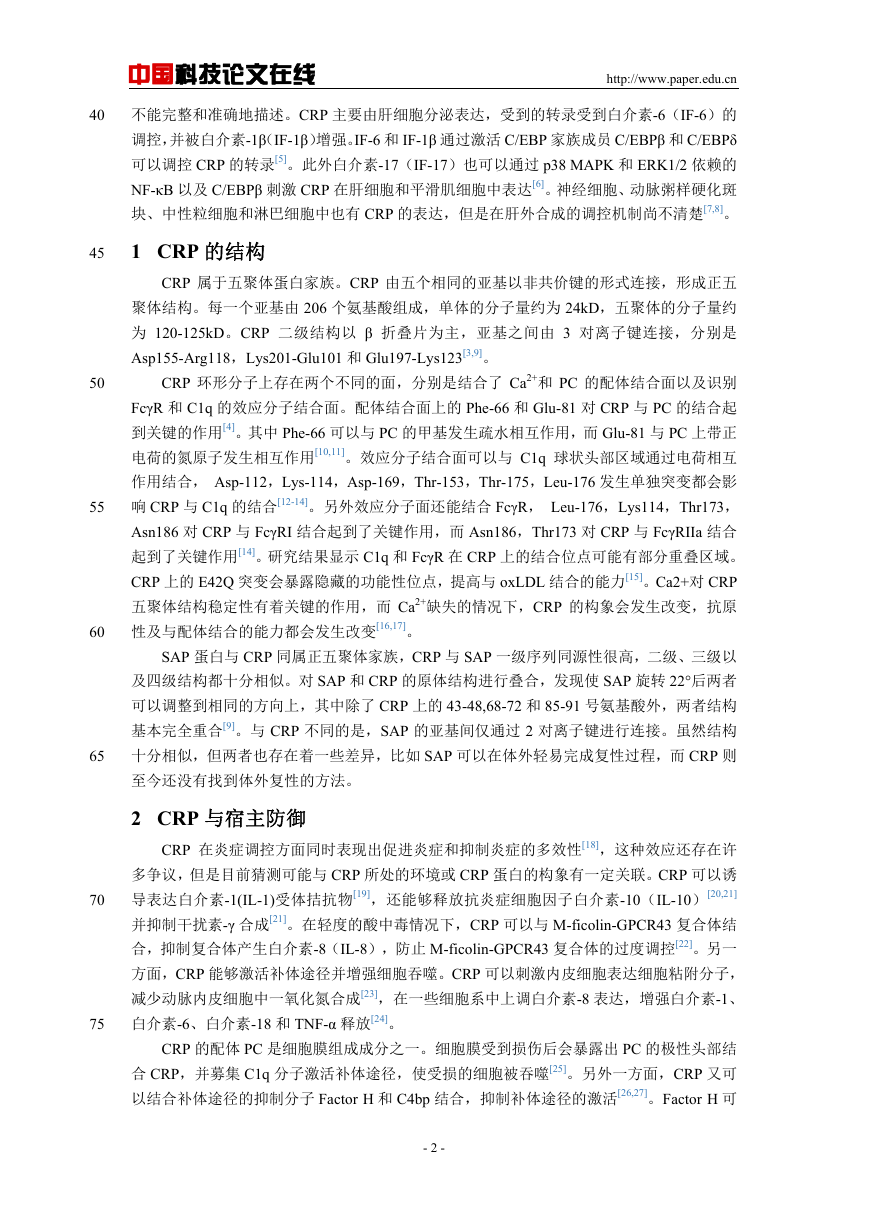
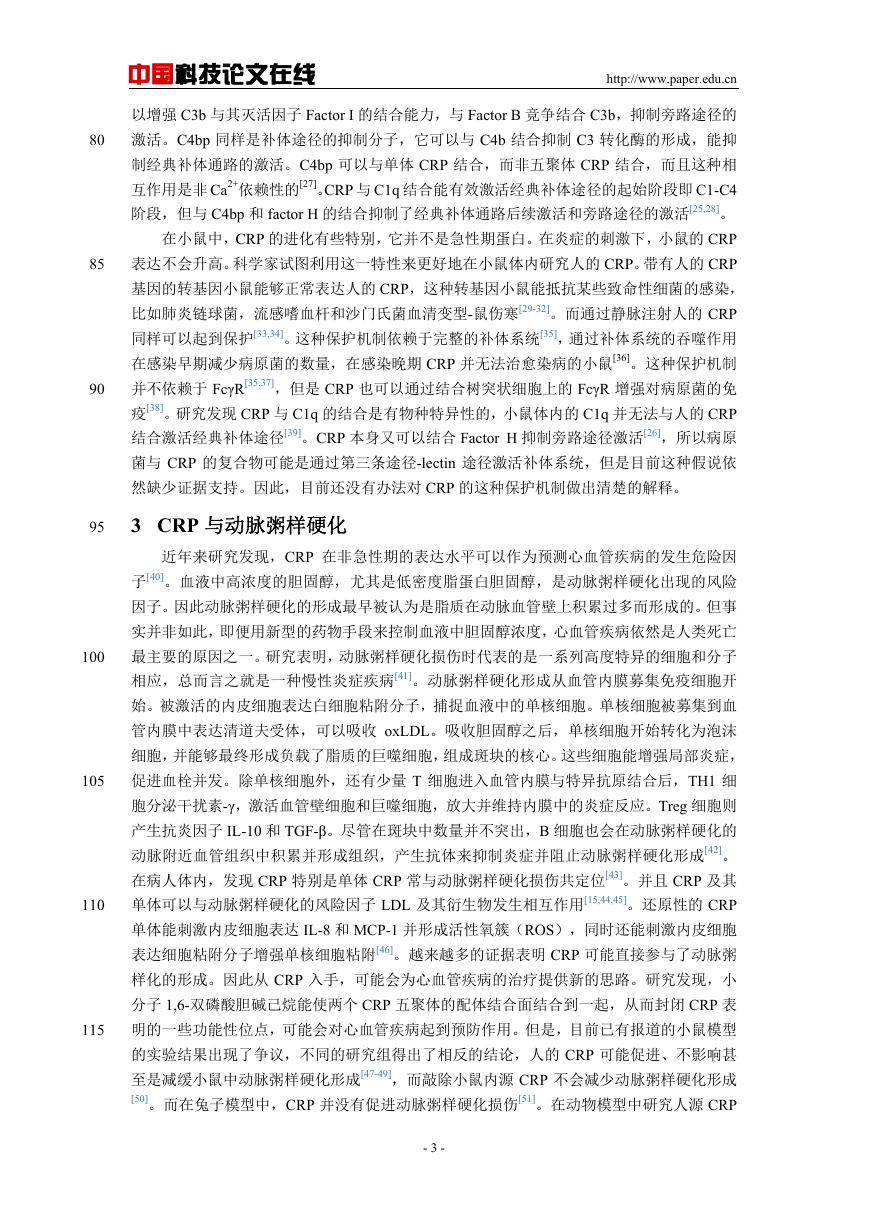
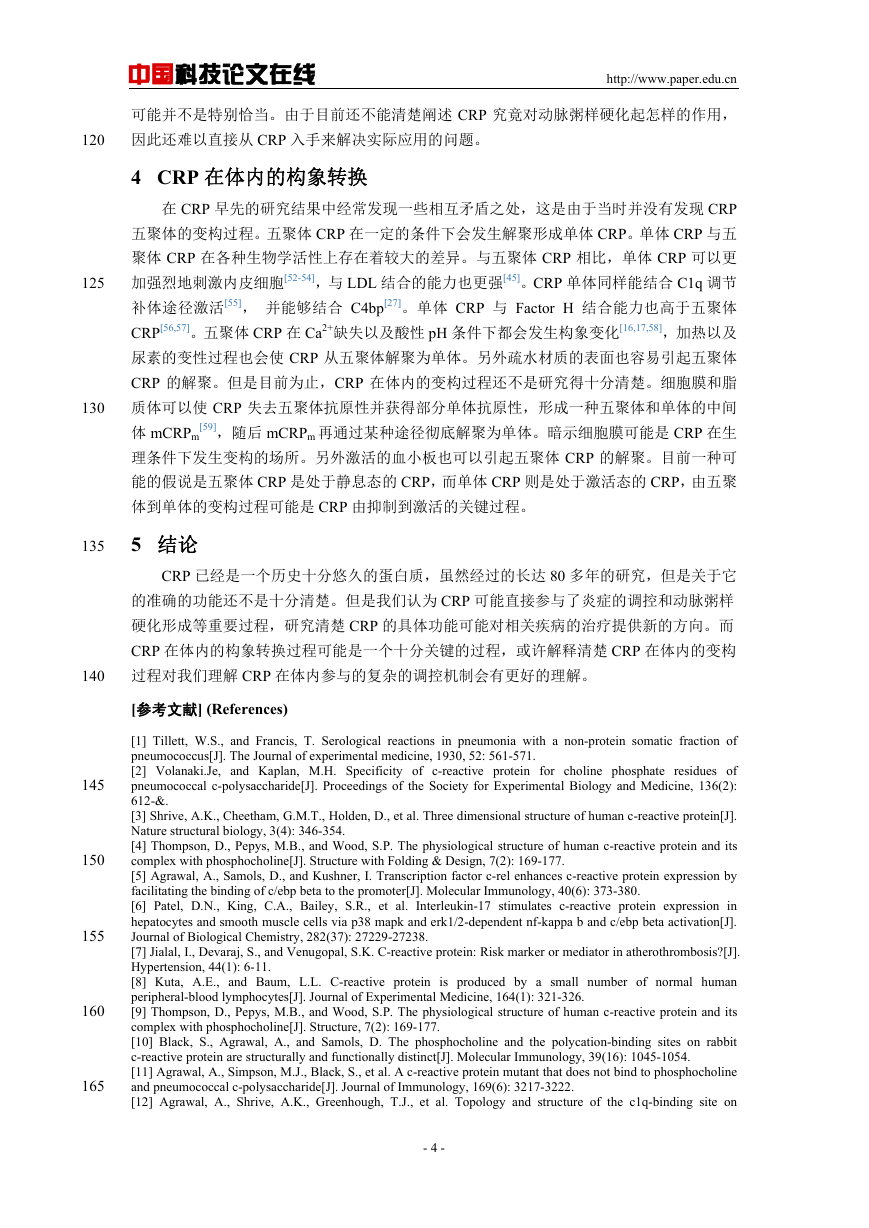
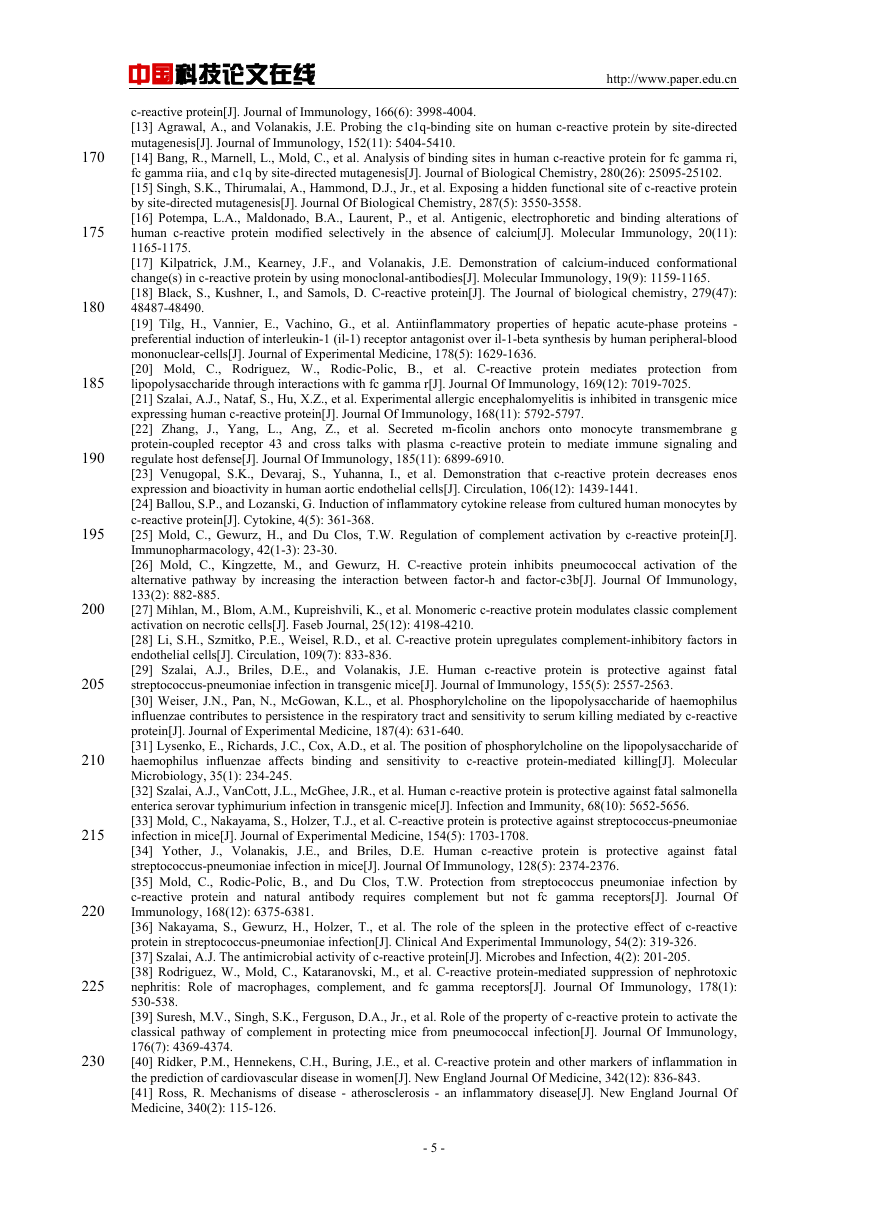
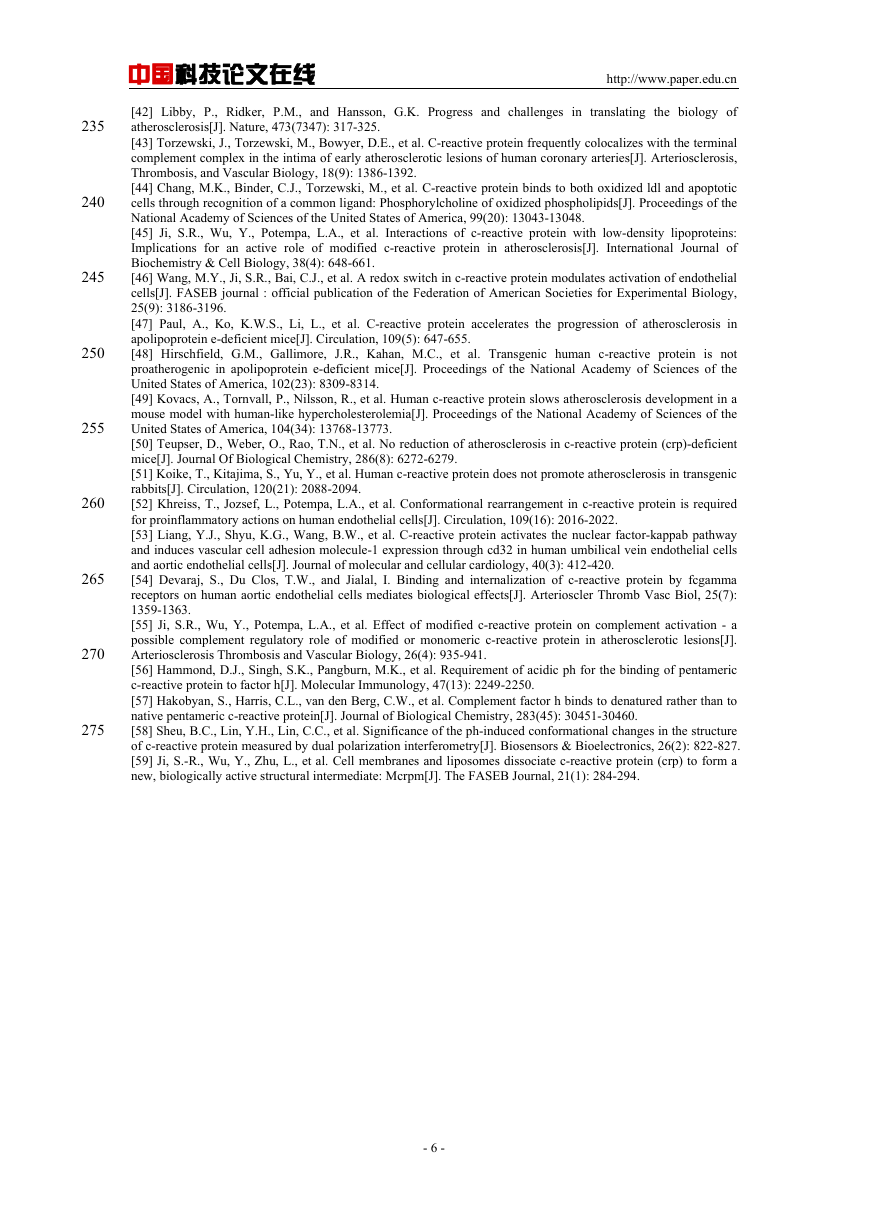






 2023年江西萍乡中考道德与法治真题及答案.doc
2023年江西萍乡中考道德与法治真题及答案.doc 2012年重庆南川中考生物真题及答案.doc
2012年重庆南川中考生物真题及答案.doc 2013年江西师范大学地理学综合及文艺理论基础考研真题.doc
2013年江西师范大学地理学综合及文艺理论基础考研真题.doc 2020年四川甘孜小升初语文真题及答案I卷.doc
2020年四川甘孜小升初语文真题及答案I卷.doc 2020年注册岩土工程师专业基础考试真题及答案.doc
2020年注册岩土工程师专业基础考试真题及答案.doc 2023-2024学年福建省厦门市九年级上学期数学月考试题及答案.doc
2023-2024学年福建省厦门市九年级上学期数学月考试题及答案.doc 2021-2022学年辽宁省沈阳市大东区九年级上学期语文期末试题及答案.doc
2021-2022学年辽宁省沈阳市大东区九年级上学期语文期末试题及答案.doc 2022-2023学年北京东城区初三第一学期物理期末试卷及答案.doc
2022-2023学年北京东城区初三第一学期物理期末试卷及答案.doc 2018上半年江西教师资格初中地理学科知识与教学能力真题及答案.doc
2018上半年江西教师资格初中地理学科知识与教学能力真题及答案.doc 2012年河北国家公务员申论考试真题及答案-省级.doc
2012年河北国家公务员申论考试真题及答案-省级.doc 2020-2021学年江苏省扬州市江都区邵樊片九年级上学期数学第一次质量检测试题及答案.doc
2020-2021学年江苏省扬州市江都区邵樊片九年级上学期数学第一次质量检测试题及答案.doc 2022下半年黑龙江教师资格证中学综合素质真题及答案.doc
2022下半年黑龙江教师资格证中学综合素质真题及答案.doc